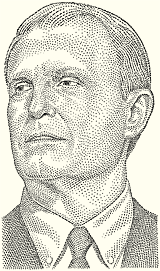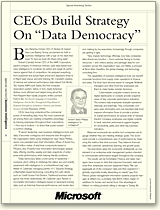CEOs Build Strategy On "Data Democracy"
This section is from the Winter 2006 issue of strategy+business
CEOs Build Strategy
On “Data Democracy”
Barry Beracha, former CEO of Skokie, Ill.–based Sara Lee Bakery Group, proclaimed his faith in business intelligence with a sign on his desk that read: “In God we trust. All others bring data.”
Robert Crandall, former CEO of the AMR Corporation, parent company of American Airlines, used data-based business intelligence to scrutinize his airline and weigh its performance against that of competitors. He analyzed everything from published and actual flight arrival and departure times to in-flight meal menus and pilot training. Mr. Crandall’s mastery of internal and external performance data helped Fort Worth, Tex.–based AMR build Sabre, the first computer reservation system. Sabre, in turn, made American Airlines more efficient and helped bring about the first frequent-flyer loyalty program, writes Leonard Fuld in the The Secret Language of Competitive Intelligence: How to See Through and Stay Ahead of Business Disruptions, Distortions, Rumors, and Smoke Screens (Crown Business, 2006).
CEOs have long understood the commercial power of harvesting data. Now, the most sophisticated among them are creating competitive advantage by training employees throughout their corporations — from top to bottom — to direct that power toward a common strategy.
“If senior leadership uses business intelligence tools and data, it becomes contagious and everyone else throughout the organization starts using intelligence,” says Steve Phillips, senior vice president and chief information officer of Avnet Inc., a $14 billion maker of electrical components based in Phoenix, Ariz. Powerful new information technologies analyze data, offering monthly, weekly, and daily snapshots of enterprise-wide performance, while helping identify problems.
“Data democracy takes a bold sense of leadership — someone who’s willing to challenge the status quo and smartly experiment with intelligence in a nontraditional way,” says Walter A. Callender, managing partner of C Squared Strategy, a Manhattan-based technology consulting firm with clients such as Credit Suisse First Boston. Traditional business intelligence has three weaknesses, Mr. Callender says: flawed or incomplete information; strategies based on backward-looking data, such as historical financial performance; and insular decision making by top executives. Increasingly, though, companies are getting it right.
“Very mature technology offerings now help companies take almost any function — from customer-facing to human resources — and collect, assess, and package data for consumption across the organization,” says Jon Watts, a principal at Booz Allen Hamilton, the global strategy and technology consulting firm.
The capabilities of business intelligence tools can benefit corporate functions from supply chain operations to finance and sales. The tools have become easier to navigate: Midlevel managers and other front-line employees use them to make faster, smarter decisions.
Customizable computer screens known as digital dashboards or cockpits provide snapshot views of key corporate performance indicators. The screens help employees evaluate operations internally and externally. They consolidate company-wide information and cull important data from massive information flows to provide a picture of overall performance. At several units of General Electric Company, employees use digital cockpits to track real-time performance against targets for productivity, sales, and other key business indicators.
Balanced scorecards are another tool companies use to gauge whether they are meeting strategic goals. The scorecards provide a comprehensive view of performance by measuring the metrics that drive success. They balance financial data with customer, operational, learning, and growth goals.
Top executives apply the scorecards strategically as one element in an enterprise-wide management system intended to communicate performance targets throughout the company.

Avnet’s Steve Phillips:
Intelligence “is contagious”
The results can be formidable: Finance and sales managers have access to data that improves forecasts; retail and shop-floor employees discover equipment flaws. “We can aggregate all of the company’s data and then segment it — globally, regionally, locally, depending on needs,” says Eric Piersol, global management information systems projects manager at Alltech Inc., a privately held $300 million maker of additives for human and animal food. One advantage to Alltech: no rotting products sitting in storage in Turkey. Mr. Piersol says an intelligence system Alltech installed in 2004 helps the company fulfill last-minute change requests and sell soon-to-expire products.
Alltech’s international offices operate independently, but data is centralized at company headquarters in Nicholasville, Ky. It wasn’t always that way. With operations in 87 countries, including Turkey, Thailand, and Ireland, Alltech found it difficult to track products — a common problem in an industry whose products have long lead times and short shelf lives.
The company ships food additives from Ireland to Turkey, where it uses a customs broker and pays taxes on goods after they clear customs. If its Turkish shelves are full, it can hold products at the pier until its information systems show a need for new stock. “It has made us a lot more proactive about expiration dates,” Mr. Piersol says. Better information now saves money for the company and time for its employees.
Alltech’s software aggregates data from its 14 global manufacturing sites, according to Mr. Piersol. The result is dynamic information that can be viewed in different ways, depending on the user’s need. Regional and local managers receive daily reports on what products are expiring. The reports once took several days; now they can be completed in 30 minutes. The intelligence system also helps the company improve customer response time: It takes just a few minutes for a sales manager short on products in Munich to scan inventory in other European warehouses. Moving goods more quickly can result in higher profits for both Mr. Piersol and Alltech’s customers.
Michael Pfitzmann, a Booz Allen principal and specialist in manufacturing strategy, says globalization has increased the flow of data that companies must track. For a manufacturer headquartered in Detroit, that could include wage changes in Eastern Europe and Korea, the price of steel worldwide, and China’s policy on currency valuation. Getting bad or incomplete intelligence can drain profitability, he says. In one case, a company thought it was taking advantage of opportunities to improve its cost structure by opening a plant in Vietnam. But low productivity and poor quality caused its chief operating officer to rethink the design of his company’s entire manufacturing footprint, write Mr. Pfitzmann, Dermot Shorten, and Curt Mueller in The Missing Link: Designing Supply Chains for Growth, Profitability, and Resilience (strategy+business Books, 2005). Mr. Pfitzmann says regular and credible intelligence can help companies avoid expensive problems.
CIOs are designing intelligence systems linked directly to corporate performance data. “The type of intelligence you collect should be driven by your business strategy,” says Niel Nickolaisen, CIO and director of strategic planning at Headwaters Inc. of South Jordan, Utah. Recalling Harvard Business School Professor Michael Porter’s landmark book Competitive Strategy: Techniques for Analyzing Industries and Competitors (The Free Press, 1980), he says companies should design their guiding strategy from three generic choices — lowest cost, differentiation, and focus — and use intelligence to support those choices.
Mr. Nickolaisen says the guiding strategy of Headwaters, a $1.1 billion conglomerate whose businesses include alternative energy and construction materials manufacturing, is to be a customer solutions leader. That means its intelligence efforts focus on developing knowledge about its customers and prospective customers that competitors don’t have. Mr. Nickolaisen believes it is vital to prioritize intelligence projects by the value they bring to the overall business. “Sure, we gather internal performance information, but where we do our deep thinking, where we invest in innovation, is in intelligence related to customer solutions,” he explains. In other words, Mr. Nickolaisen says, it would be unwise for Headwaters to customize its enterprise resource planning system, and the company doesn’t focus on supply chain innovations.
One place the company does focus its deep thinking is on expiration dates for contracts its prospective customers have signed with its competitors. These are long-term, 5- to 10-year contracts. Mr. Nickolaisen says Headwaters started tracking such agreements with the intention of alerting its salespeople to be in touch with prospects several months before the contracts with competitors expired.

CIO Niel Nickolaisen:
Customer-focused intelligence
Just as the field of business intelligence has expanded beyond the leadership ranks, it has also broadened beyond its original realm of big companies with large information technology departments.
Tekelec Inc. of Morrisville, N.C., is a fast-growing telecom network equipment manufacturer and distributor. Its 2005 revenues reached $540 million, up 46 percent from 2004. It turned to business intelligence to help it meet quality requirements as its orders rapidly expanded.
The company’s major customers — including Cingular Wireless and Verizon Network Services Group — are part of the Quality Excellence for Suppliers of Telecommunications (QuEST) Forum, a consortium that outlines product quality requirements in its TL 9000 handbook. Fulfilling the handbook’s guidelines requires detailed monthly reports on customer trouble tickets, hardware problems, and other balanced scorecard performance indicators.
Creating those reports was cumbersome until Tekelec installed a business intelligence system that its quality assurance staff could tap. “The BI system shortens cycle time for customer feedback. We can collect information about process defects and respond to them before they affect customers,” says Chuck Stormon, Tekelec’s vice president of strategy. What’s more, the staff time spent creating TL 9000 reports has fallen from a week to half a day.
Tekelec makes performance indicators available internally on internal Web pages. In Tekelec’s terms, various departments “own” different areas of intelligence. For instance, performance metrics, such as how fast Tekelec handles a customer complaint, are owned by the customer service department. Tekelec’s engineers own data related to product quality.
To drive business insight at multiple levels, Tekelec compiles the performance data for executives interested in regional and global views of operations. “Our business cycle dictates a quarterly rollup,” Mr. Stormon says.
Now that Tekelec’s quality assurance employees have access to customer performance metrics, business intelligence staff who once spent time filling information requests spend more time on strategic activities.
Mr. Stormon says such activities include developing new ways to offer business intelligence to Tekelec customers, such as analyzing bills between phone companies for errors. Bills that phone companies send to one another are book-length, byzantine in complexity, and sometimes inaccurate. That can translate into a loss of revenue and potential liabilities. “With the Sarbanes-Oxley Act, CEOs face criminal and civil liabilities for material misstatements,” Mr. Stormon points out. Tekelec now provides third-party authentication of bills’ accuracy.
The importance of business intelligence is boosting the role of CIOs from that of data manager to provider of mission-critical information. It’s a double-edged sword. The more weight companies attach to intelligence, the more likely a CIO will face corporate board scrutiny. Information security concerns, financial regulations, and the highly publicized failures of intelligence systems at some large publicly traded organizations have all given corporate directors new reason to pay close attention to IT. The FedEx Corporation and Procter & Gamble Company are just two organizations that have set up board subcommittees focused on information technology.
|
The CIO, who joined Avnet last year when the electronics company acquired Memec, a smaller semiconductor distributor for which Mr. Phillips also worked as CIO, says Avnet’s long-term intelligence goals include expanding end-to-end connectivity with suppliers and customers, providing world-class materials management, and setting the company’s enterprise resource planning strategy.
“Business intelligence captures the essence of how we’re doing,” says Mr. Phillips. Many companies use customer purchasing history and trend data to increase cross-selling and up-selling opportunities. Avnet has developed a system to create reports on sales orders, product shipping schedules, and dates when a product will no longer be made. Some 2,000 salespeople use the system and let customers know if a particular product will soon be phased out. They also identify new products that will replace the old.
One of Mr. Phillips’s short-term objectives is establishing monthly scorecards for operational and project delivery. The company has Web-enabled tools that provide clear graphics and data, but it is still working out thresholds for achieving scorecard goals. For instance, the company measures the availability of the IT system monthly. If it is available 100 percent of the time, the team gets a green light. But if there is an outage and the system is not available for a short period — half an hour, for instance — Phillips says a yellow light may be unfair. “We want to set thresholds that drive good behavior, but are not unnecessarily harsh,” he explains.
CEOs are giving information chiefs broad latitude to create data-centric organizations capable of transforming information from multiple, fragmented sources into enterprise-wide insights.
Kevin Stack joined Jo-Ann Stores Inc. last year with two decades of experience in information technology. The CIO says the $1.9 billion Hudson, Ohio–based crafts supply retailer collects data on everything from sales transactions to inventory. It’s collected daily, aggregated, and delivered across the enterprise.
The trouble is that no one seems to agree on standard reporting information. Mr. Stack says he’s reforming the information system. “In the past we were data delivery experts — very good at servicing requests for data. Going forward, we’ll be delivering information the business can use to make decisions,” he says.
That requires major changes in how the company reports information. Mr. Stack names standardization as his top priority. “When three category managers all come in with different numbers at the end of the day, you have a situation where no one knows which is right,” he says. Disparities include differences in how store managers record full-price sales and discounted sales.
Mr. Stack is beginning the reform by establishing standard definitions for key metrics among managers of the company’s 840 stores.
Clean data and a thorough understanding of corporate goals are crucial to the performance of a balanced scorecard system. Over the next 18 months, Mr. Stack plans to develop both scorecards and dashboards. He says the tools serve different levels of the organization — scorecards are particularly helpful for midlevel managers who need to see details on service levels and order fulfillment. Dashboards create an enterprise-wide view that’s important for corporate executives. “Both require a single version of the truth,” says Mr. Stack.
How Harrah’s Data Mining Hit the Jackpot
The most profitable customers at Harrah’s casino in Las Vegas don’t fit the stereotype of jet-setting, high-stakes gamblers. They don’t come for the sleek, well-appointed hotel rooms or the high-tech conference facilities. They’re more likely to bet a few hundred dollars a night than a few thousand. Harrah’s best clients are local retired and semiretired people who visit the company’s casinos often and gamble more for entertainment than to break the bank.
No one knew that before 2003, when Gary Loveman, a former Harvard Business School professor, arrived at Harrah’s Entertainment Inc. to take over as chairman and CEO. Mr. Loveman built a corporate culture based on challenging business assumptions through the use of data-driven intelligence. He identified local gamblers as Harrah’s most profitable customer segment and proceeded to woo them. The result has been increased profitability at the largest U.S. casino company.
“Casinos produce lots of data — on things like revenue, occupancy, profitability, and staff turnover. Loveman was determined to use those data…by constantly running small experiments to uncover facts that would help the company make more money,” write Jeffrey Pfeffer and Robert I. Sutton in Hard Facts, Dangerous Half-Truths, & Total Nonsense (Harvard Business School Press, 2006).
Mr. Loveman came to Harrah’s with a commitment to rigorous analysis and fact-based decisions. He invested in data warehousing and analytical tools for in-depth assessment of guest behavior. And then he rewrote the rules of the gaming business.
According to Messrs. Pfeffer and Sutton, Mr. Loveman is among a new breed of business leaders who have introduced to business management a principle from the medical establishment: Decisions should reflect the best understanding of what works. These executives nurture an obsessive hunger for facts and up-to-date information as a means of refreshing corporate beliefs, practices, and strategy.
At Amazon.com, the online retailer, CEO Jeffrey Bezos says it’s every employee’s job “to maximize invention per unit of time.’’
“No brag, just facts,” is the motto of Kent Thiry, CEO of DaVita Inc., a leading U.S. provider of dialysis services.
Experimentation that challenges conventional thinking is the foremost tool in Mr. Loveman’s portfolio at Harrah’s. In one test, the gaming company gave customers a $125 promotional package that included a free room, two steak dinners, and $30 worth of gambling chips. It gave a second group of customers $60 worth of chips. Confounding expectations, the second offer generated more gambling and higher profit despite increased costs. It also contradicted the belief that most gamblers are attracted by a free hotel stay, report Messrs. Pfeffer and Sutton.
Similarly, although radio and television advertisements were the conventional approaches to luring casino customers, Mr. Loveman turned to direct mail. He succeeded in attracting regulars during traditionally quiet times.
About $50 billion flows through Harrah’s slot machines yearly, and Mr. Loveman initiated tests to see whether increasing “holds” — the money put into slot machines that the casino keeps — would send gamblers scurrying for exits. Experiments revealed that the company could indeed pay out less without materially impacting players’ behavior. “Harrah’s discovered that you could increase the hold, generating additional money that fell straight to the bottom line,” according to Messrs. Pfeffer and Sutton.
A robust business intelligence strategy won’t work without supportive leadership from the CEO, the authors say. Managers can put together the pieces: They can determine the metrics behind a strategy and establish standards and a language for communicating that strategy. But a company’s top leaders are the only executives who have the clout and perspective to create the cultural changes that can support business intelligence corporation-wide.
Such change can be a terrifying prospect. “Facts and evidence are great levelers of hierarchy. Therefore, some of the resistance to evidence-based practice arises because, when done right, it does change power dynamics, replacing formal authority, reputation, and intuition with data,” observe Messrs. Pfeffer and Sutton. CEOs risk diminished stature if the power of their intuition is replaced by evidence-based insight available to any educated person with access to data. This may account for some CEOs’ reluctance to wholeheartedly embrace business intelligence.
In creating a data-driven culture, fear is just one of several hurdles. Another obstacle is denial. CEOs — like everyone else — don’t always want to hear the truth. Few employees will volunteer to deliver bad news, even if it’s fact-based, if a CEO isn’t prepared to hear it. Yet another hurdle to implementing an intelligence-based corporate strategy is the difficulty of isolating relevant facts amid a torrent of clashing data.
Corporate cultures that profit from intelligence follow several standards, according to the authors. These include:
- A skeptical interest in breakthrough ideas and studies combined with the discipline to thoroughly test them and the willingness to say they’re wrong (because they almost always are).
- A commitment to celebrating communities of smart people and collective brilliance, rather than championing lone geniuses or gurus.
- An emphasis on both the virtues and the drawbacks of research and the practices it suggests.
- An understanding that stories of success and failure, although valuable as illustrations, are not in themselves valid evidence of a correct policy.
This is the third of three reports sponsored by Microsoft Corp. in strategy+business examining strategic trends. The focus of this section is business intelligence. The first two sections discussed streamlining business operations and integrating customer service. The articles are created by the publishing department of strategy+business.
Illustrations by Kevin Sprouls






